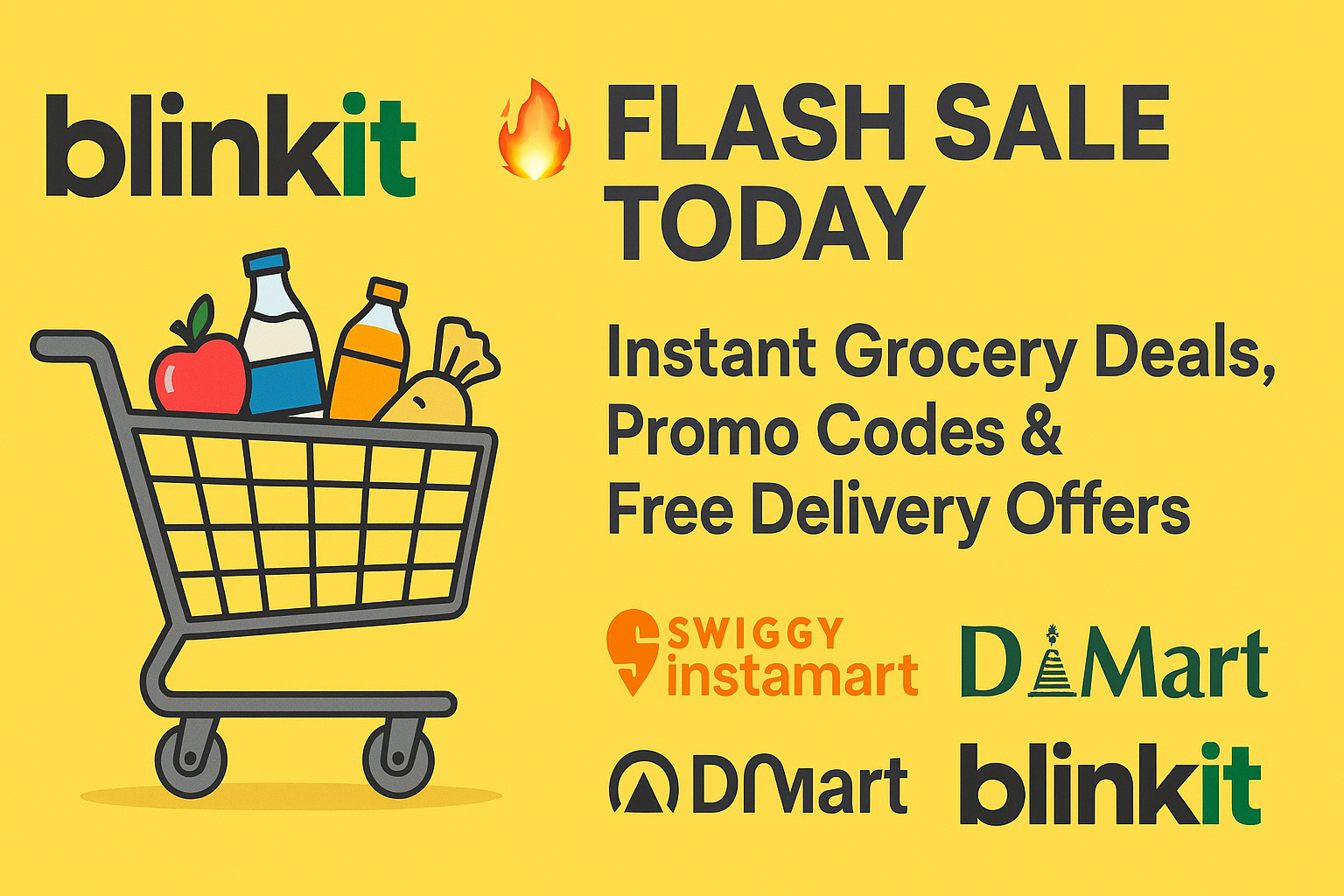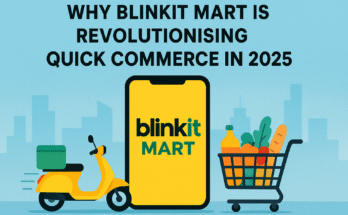Quick summary (jump to):
- Why Blinkit matters now
- Growth story & key milestones
- Market snapshot (2025)
- Business model & unit economics
- Operational strengths & tech stack
- Challenges and risks
- Strategic moves & the road ahead
- Takeaway & quick checklist for stakeholders
Why Blinkit matters now
Blinkit (acquired by Zomato in 2022 and integrated into the company’s quick-commerce push) sits at the center of India’s rapid “q-commerce” expansion. The model—delivering groceries and essentials in under 10–20 minutes from micro-fulfillment hubs—has moved from niche convenience to a mainstream channel in 2024–25, altering how urban consumers shop for daily needs. The acquisition and strategic focus made Blinkit Zomato’s vehicle into instant grocery, and its recent growth has drawn investor and analyst attention. Moneycontrol+1
Growth story & key milestones
- Acquisition & integration (2022): Zomato’s all-stock acquisition (reported as ~₹4,447 crore) established Blinkit as Zomato’s quick-commerce arm. mint
- Scale & GMV acceleration (2024–25): Blinkit’s net order value and GMV grew strongly in FY25, with some reports showing order/network growth outpacing traditional food-delivery within its parent group. Analysts highlighted steep YoY increases in Blinkit’s net order value. Reuters
- Competition & market dynamics (2025): Rival players (Zepto, Instamart) raised capital and expanded aggressively; Zepto’s large fundraise in 2025 intensified competition. The sector is in a fast expansion phase, pushing more marketing and geographic reach. Reuters+1
Market snapshot (2025)
| Metric | Estimate / Status (2025) | Source / Note |
|---|---|---|
| India q-commerce market size (FY25) | ~₹64,000 crore (approx.) | CareEdge / sector reports. Care Ratings |
| Projected annual growth (to 2030) | ~40% CAGR (q-commerce growth projection) | Bain & industry analysis. Bain |
| Share of e-grocery orders from q-commerce (2024) | ~two-thirds of e-grocery orders | Bain / Reuters reporting on 2024 share. Reuters |
| Leading players | Blinkit (Zomato/Eternal), Zepto, Instamart, Amazon/Flipkart micro-fulfillment | Market landscape; competition intensifying. CTFE+1 |
Note: Market figures vary by report—CareEdge and Bain are representative industry sources; readers should view them as the current consensus range rather than exacts. Care Ratings+1
Business model & unit economics
Blinkit’s core proposition is: low SKUs, high frequency, super-fast delivery. Key unit-economic levers:
- Average order value (AOV): Lower than full-basket grocery but higher frequency compensates.
- Delivery cost per order: High in micro-delivery model — mitigated via shorter distances, batch routing, and density at kirana/micro-hub level.
- Fulfillment cost: Micro-fulfillment centers (MFCs) increase stocking/real-estate costs but reduce last-mile time and cost per minute.
- Marketplace & advertising revenue: Q-commerce players increasingly monetise through in-app promotions, advertising, private-label SKUs, and partnerships — reducing dependence solely on delivery margins. Reports indicate advertising income for quick commerce networks grew as platforms leaned on ad revenue. exchange4media.com+1
Blinkit KPI table (illustrative)
| KPI | Direction in 2024–25 | Why it matters |
|---|---|---|
| Orders / month | Rapidly increasing | Volume drives fixed-cost absorption |
| Frequency per active user | Rising | Improves lifetime value (LTV) |
| Fulfillment centers (MFCs) | Expansion into non-metro cities | Increases reach but raises opex |
| Contribution margin per order | Improving (but mixed by market) | Signal of path toward profitability |
| Ad & marketplace take | Growing as % of revenue | Diversifies revenue streams. exchange4media.com |
Operational strengths & tech stack
- Hyperlocal inventory planning: Blinkit uses demand forecasting and localized assortments to ensure high-turn SKUs are available close to customers.
- Dense micro-fulfillment network: Small fulfilment hubs (~200–500 SKUs) placed in dense urban pockets to hit 10- to 20-minute SLAs.
- Routing & last-mile optimization: Algorithms route riders to maximize multi-drop efficiency, lowering per-order delivery cost.
- Platform synergies with parent company: Access to Zomato’s customer base, payments stack, and restaurant/logistics learnings helps cross-sell and reduce CAC (customer acquisition cost). Moneycontrol+1
Challenges and risks
Blinkit’s model faces a set of structural challenges that determine whether quick commerce stays a profitable long-term segment:
- Unit economics & sustainability: Delivering under 15 minutes is expensive. Unless AOV rises, per-order contribution may remain thin. Many players offset this with advertising, private label, or dynamic pricing — but these are limited levers. Bain
- Competition & ad spend war: Deep-pocketed rivals (e.g., Zepto’s funding rounds) can fund aggressive expansion and price subsidies, increasing CAC and compressing margins for all players. Reuters+1
- Geography & scale tradeoff: Expansion beyond metros dilutes density and raises delivery time/cost unless there’s sufficient urban density.
- Regulatory & labour dynamics: Increasing automation (and reported layoffs at parent groups) plus labour regulation changes can alter cost structures and public perception. Recent layoffs in Zomato’s broader operations illustrate the push toward automation in the sector. The Times of India+1
- Inventory & wastage: Groceries are perishable; poor forecasting can increase shrink and write-offs, hurting margins.
- Customer behavior risk: The stickiness of 10-minute delivery is not assured—if convenience premiums rise, customers may revert to traditional weekly shopping for many categories.
Strategic moves & the road ahead
Blinkit and players like it are exploring multiple strategic paths to make q-commerce durable:
1) Diversify revenue beyond delivery
- Grow advertising and in-app promotions; private labels; subscription programs; and partnerships with brands for exclusive launches. This reduces reliance on delivery margins. Industry reports show advertising becoming an important revenue line for marketplaces and quick commerce networks. exchange4media.com
2) Improve unit economics via density & tech
- Optimize MFC placement, multi-pick rider routing, and smart batching to lower per-order delivery cost. Investing in forecasting tooling and SKU rationalization reduces stockouts and wastage.
3) Selective market expansion
- Focus on densest micro-markets first (top metros + Tier-2 city pockets) where the time promise and density overlap. This helps scale profitably before broader rollout.
4) Leverage parent ecosystem
- Cross-sell to existing food-delivery customers, bundle subscriptions, and use shared logistics or hubs to amortize costs across business lines. Blinkit’s parent organization gains from these synergies. Reuters+1
5) Path to profitability
- Shift attention from pure growth to contribution margin, pursue higher AOV strategies (bundling, minimum order thresholds, premium instant categories) and monetize the platform (ads, brand services).
Interlinked deep dives (use these anchors to jump quickly)
- Business model & unit economics
- Operational strengths & tech stack
- Challenges and risks
- Strategic moves & the road ahead
Recommended metrics to watch (for investors / managers / product leads)
| Metric | Why it matters | Target direction |
|---|---|---|
| Contribution margin per order | Core profitability signal | Upwards |
| Active users / month & order frequency | Demand sustainability | Upwards |
| Fulfillment density (orders/km²) | Unit cost driver | Increase |
| Ad revenue % of total | Diversification | Increase |
| Wastage/shrink % | Inventory efficiency | Downwards |
Takeaway & quick checklist for stakeholders
- For investors: Q-commerce is high growth but capital and execution intensive. Look for improving unit economics, diversified revenue, and clear path to positive contribution margins. Care Ratings+1
- For operators: Focus on densest micro-markets, SKU rationalization, and cross-monetization (ads/private label). Use data to optimize rider routing and forecasting. exchange4media.com
- For brand partners / FMCG: Q-commerce is a growing channel for brand activation and short-lead test launches—expect strong depending on urban clusters and promotional support.
- For customers: Faster fulfilment and convenience are winning, but expect mixed availability and higher prices versus bulk shopping.
Sources & further reading
(Selected, high-load sources used in this article)
- Zomato completes acquisition of Blinkit coverage and deal context. Moneycontrol+1
- Bain “How India Shops Online 2025” — q-commerce growth projections and market dynamics. Bain
- CareEdge / industry market reports on q-commerce market size and projected growth. Care Ratings
- Reuters reporting on q-commerce share of e-grocery and Blinkit’s role. Reuters
- Reuters coverage of Eternal/Zomato and Blinkit performance in 2025 (earnings, stock reaction). Reuters
- Industry coverage of competitive dynamics (Zepto fundraise and implications). Reuters+1
Are you planning to go grocery shopping and write on paper? why don’t you try Trupricer.com a digital shopping list creator Using trupricer mobile app, you can create a digital monthly shopping list in the app and there is no need to struggle with writing a list on paper every time
Andriod store link to download the app: https://play.google.com/store/apps/details?id=com.trupricer.user
IOS app store link :https://apps.apple.com/in/app/tru-pricer/id6480042106




